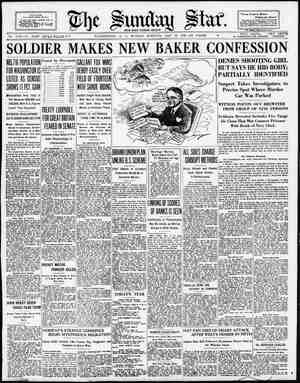Evening Star Newspaper, May 18, 1930, Page 95
You have reached the hourly page view limit. Unlock higher limit to our entire archive!
Subscribers enjoy higher page view limit, downloads, and exclusive features.
Solves the Famous Indian Stone Hoax THE SUNDAY STAR, WASHINGTON, D. C, MAY 13, 1930. For More Than a Hundred Years Cryptic Writing Found in a West Virginia Mound Has Baffled the World’s Best Scientists, But a Painter Who Could Read Scrawls and Who Knew His Dickens Appears to Have Cleared Up the Mystery at Last. BY EMILY C. DAVIS. IL STUMP’S STONE Oct 14 1838" This inscription in cabalistic writing, cut into a little piece of stone, has baffled scientists both in America and abroad ever since #t was dug out of an Indian mound in West Virginia almost a century ago. ] Many experts on languages tried in all seri- ousness to translate the' cryptic writing, be- leving it to be written by ancient man in Canaanite, Celtic, Runic, or whatnot. Some of the scholars announced success, and strange and weird were their translations. It has finally taken a West Virginia printer, who knows his Dickens and who has a keen 66 enthusiastic individual cut himself off pre. maturely, in despair at being unable to fathom its meaning. That Mr. Pickwick was elected an honorary member of 17 native and foreign societies, for making the discovery; that none of the 17 could make anything of it, but that all the 17 agreed it was very extraordinary.” Then came forward a Mr. Blotton “with the doubt and cavilling peculiar to vulgar minds” and a theory of his own. He Nhad cross- questioned the man who sold the stone and had been assured that the stone was indeed ancien Just as he informed Mr. Pickwick. 3 But the inscription on ®, that was quite an- other matter. The cottage owner had earved This drawing of Phiz shows Mr. Pickwick’s eager discovery of a mysteriously inscribed stone, It was this satire by Dickens that must have inspired some long- dead and unknown West Virginian joker to “plant” the Grave Creek Stone. There were two vaults discovered in the interior of the mound. One vault contained a single human skeleton and the other vault two. Little was known about the mound-building. The printer, Andrew . He is president of Historical Society and & Dr. Walter Hough, curator of archeology of the United States National Mu- seum. holding a raré cast of the Grave Creek Mound inscription, which has been in the museum for half a century. The original stone disappeared years that to amuse himself one day, and it sald k Mound in the 1840's, shortly after the discovery of the faked stone _amd she genuine skeletons. A §rick cham handling large enterprises, involving organized It was commonly believed that people with all these gttainments could not be Indians,
